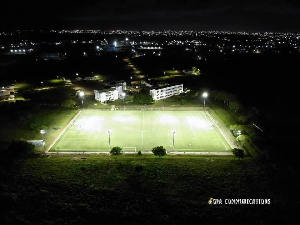- Home - News
- TWI News | TV
- Polls
- Year In Review
- News Archive
- Crime & Punishment
- Politics
- Regional
- Editorial
- Health
- Ghanaians Abroad
- Tabloid
- Africa
- Religion
- Election 2020
- Coronavirus
- News Videos | TV
- Photo Archives
- News Headlines
- Press Release
General News of Friday, 28 December 2001
Source: .
Ghana's population 18.8 million
Ghana's population is now 18.8 million, according to figures released by the Ghana Statistical Service in Accra on Friday.
The figure, which emerged out of the 2000 population and housing census, represents a 15 per cent increase over the 1984 headcount of 12,296,081. It also represents a growth rate of 2.6 per cent.
Announcing this in Accra, Dr Kweku Twum-Baah, acting Government Statistician, said while the rate was high in comparison to the 1.5 per cent for the world and it was the average for less developed countries which stands at 2.0 per cent.
It is the same for Sub-Sahara Africa, 2.6 per cent and lower than the 2.9 for West Africa. Dr Twum-Baah said there was evidence that the growth rate in the post census period of 1984-1990 of about 2.9 per cent was the result of the mass return of Ghanaians and the inflow of refugees in response to improvements in the economy.
He said fertility rate had declined to 4.5 that translated into a growth rate of 2.4 per cent in that period, the lowest in Africa. The figure is lower than the average of 5.8 children for Sub-Sahara Africa and 5.3 per cent for Africa.
Dr Twum-Baah said if the growth rate continued to decline, Ghana's population was likely to record less than 24 million for the next census in 2010. The acting Government Statistician said the population figure yielded a density of 78.9 persons per square kilometre.
"While this may indicate no great pressure of population on land, the same cannot be said of pressure on resources that the land can generate."
Dr Twum-Baah named Ashanti Region as the most populous region with 19.1 per cent of the population, followed by Greater Accra with 15.4 per cent and Eastern Region with 11.2 per cent.
Ghanaians by birth or parenthood make up 92.1 per cent of the population while non-Ghanaians constitute 3.9 per cent.
Dr Twum-Baah said Akan emerged the most predominant ethnic group with 49.1 per cent, followed by Mole Dagbani with 16.5 per cent, Ewe, 12.7 per cent and Ga-Dangme eight per cent.
He said the pattern changes depending on the base region of these ethnic groups. The stock of houses was also put at 2,238,545 with two-third of these in the rural areas.
"The stock represents an increase of 82.5 per cent over the recorded stock in 1984. While the rural stock increased by about 60 per cent from 1984, the urban stock increased by 160 per cent within the same period."
He said this meant that the average number of persons per house reduced from 10.0 per cent in 1984 to 8.4 per cent in 2000. Dr Twum-Baah expressed gratitude to the government and the donor community for helping the GSS come out with results in goodtime.
Mr Yaw Osafo Maafo, Minister of Finance, said the timing for the release of the figures would help the government to plan a more specific budget for the country next year.
"This is because it allows enough time for the Electoral Commission to fulfil a constitutional mandate to use the census results 12 months from now to review constituency boundaries for effective democratic principle of equitable distribution of national resources."
He said parliament would soon come out with a legislative instrument to make it mandatory for the government to set aside funds for a census every 10 years.










